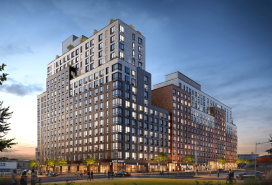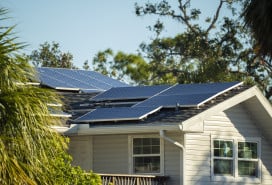Storefront map: Where have NYC's retail shops gone?
We've heard a lot lately about softness at the top of the rental market, due in part to an oversupply of units in high-end, new developments. WNYC reports that the city's commercial real estate market, too, may be struggling, given the large amount of storefronts sitting empty.
"Walk around some of the busiest and most prosperous neighborhoods, and you may see a lot of 'For Rent' signs," observes reporter Ilya Marritz. To find out just how many, he taps Justin Levinson, a longtime New Yorker who has been mapping Manhattan's vanishing retail on his site, Vacant New York.
Levinson's interactive map reveals a worrying image of neighborhoods—even busy and wealthy ones, like Greenwich Village, Tribeca, and Soho—that are heavily pocked with the red dots that represent empty storefronts.
Levinson points to high rents as one major explanation of why this is happening, and costly rent does seem to be an issue that affects even high-end businesses. Take the Union Square Cafe, for example, the fine dining establishment that put restaurateur Danny Meyer on the map: In 2014, Grub Street reported that Meyer decided to close the restaurant because of a steep rent hike. (The spot has since reopened in a new, and presumably cheaper location.)
Jeremiah Moss, the blogger behind Vanishing New York, seems to agree, dubbing the vacant storefronts that result from these kinds of closures "high-rent blight." He points to the shuttering of Mon Petit Cafe, an Upper East Side French bistro open since the 1980s, as an example of rent hike-induced vacancy. On their Facebook page, the bistro's owners write, "...the climate for small business like ours in New York City has become a crushing force. Mom-and-pop stores of all kinds are now an endangered species in our city."
But some wave off this characterization as overblown. Steven Soutendijk, an executive managing director for Cushman & Wakefield, for instance, told WNYC that the level of retail vacancies the city is seeing now is not above average. He attributes some of the empty stores to changing trends, citing as an example New Yorkers' fading yen for fro-yos, which may have led to a number of Pinkberries (and its imitators) shuttering.
In an op-ed for Crain's, however, writer Greg David demurs, saying that we've reached a "tipping point" in the retail landscape, due to a confluence of pressures that includes high rents, prohibitively long leases, and competition from e-commerce. Even huge chain stores, David writes, are in trouble here, having oversaturated the commercial real estate market. And as Levinson points out, at least a national chain like Starbucks can provide a setting where people still have meaningful experiences, whereas empty storefronts do nothing to bolster the vibrancy and character of neighborhoods. (Urban planner Ethel Sheffer explained to New York magazine in 2011 why empty ground-floor retail spaces can deplete a block of its energy. “It doesn’t continue to provide the kind of animated street life that most people like about cities,” she said.)
Just as is the case with residential real estate, though, as spaces stand empty, commercial landlords may soon be clued into the fact that they need to adjust their expectations—and lower prices. The New York Times reports that this is already happening along Madison Avenue, where, a broker tells the paper, annual retail rents have fallen to $1,100 per square foot from $1,800--a sign, perhaps, that the commercial market is also softening, and that it may get a little easier for mom-and-pops to stay afloat.
You Might Also Like




























